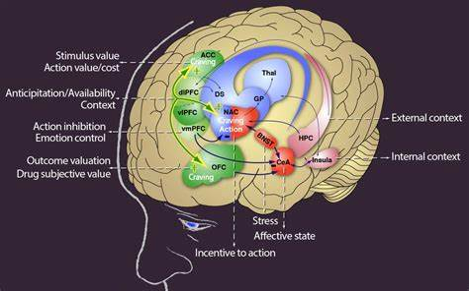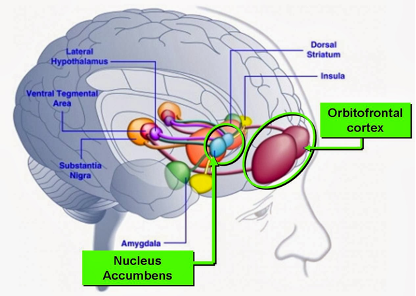The Orbital Frontal Cortex: Reward, Value, and Decision-Making
Onoseta Momodu UA‘24 and Jim Stellar
Building on the last blog on the dorsal medial prefrontal cortex, we continue here with the orbital frontal cortex (OFC), which also represents limbic processes, but in a different way according to a recent review.
First, as before, we note the idea that the 6-layer neocortex takes limbic system processes and elevates them to a symbolic logic level to facilitate cognitive decision making with other cortical brain areas. We again use the analogy from the visual cortical system that allows simple eye-tracking of an object’s movement to be turned into the object’s trajectory, like a rolling ball which temporarily goes behind a screen. The idea here is that the OFC creates value and expected value representations out of direct reward experiences. For example, the accumbens activity, might underlie a type of processing that could create drug craving like Pavlov’s dogs learned to associate feeding (and salvation) with his ringing of a bell. These kinds of symbolic higher representations are what is needed if a college student’s brain is going to integrate their emotional experiences on an internship with their cognitive plans for themselves, e.g. after working in the hospital, I know premed is the right career path for me.
Although the related functions depend on a network of brain areas, like much other higher behavioral functions (e.g. the default mode network), the OFC has the following base anatomical connections with accumbens that likely make possible this symbolic extraction. Below on the left is a diagram showing some connections with the accumbens as discussed in a recent blog on addiction. Note the direct connections between OFC and the Ventral Tegmental Area that supplies dopamine to the nucleus accumbens. Below on the right from a recent paper, are some of the OFC connections with other brain areas, noting the many connections in the cortex as well as subcortical.


From primate electrophysiology research, a function of OFC seems to be connecting the disparate stimuli to further that complete representation of value discussed in the second paragraph above. And it creates an expected positive value representation out of momentary reward activity patterns that occur in the accumbens as well as in other areas like the amygdala where a negative value comparison might originate to generate a more complete picture that might apply to obsessive disorders, for example.
The OFC is involved in planning operations that are controlled generally by the prefrontal cortex (PFC). The PFC is a region of the brain responsible for executive functions such as decision-making, planning, and working memory. The OFC is a subregion of the PFC and it has connections with other areas, such as the dorsolateral prefrontal cortex (DLPFC) and the ventromedial prefrontal cortex (VMPFC), which are also involved in planning and decision-making processes. Studies have shown that the OFC plays a key role in integrating sensory information with internal goals and values, which are important for guiding behavior and decision-making. It is also involved in the monitoring and adjustment of ongoing behavior, which is necessary for flexible and adaptive goal-directed actions. Overall, the OFC works together with other regions of the PFC to support planning operations and decision-making processes, which are essential for achieving goals and navigating the complex environments we encounter in our daily lives.
More specifically, an article on OFC brain damage discusses the emotional and behavioral changes that can occur after a traumatic brain injury. It discusses 4 classic symptoms: 1) Poor Decision Making due to the disruption of “value-based decision making,” 2) Impulsive behavior, leading to rash decision-making, 3) Decreased Emotional Responses, especially in a reduced anxiety to risky decision-making, 4) and Personality changes as exemplified in the famous Phineas Gage story. In addition, the OFC plays a critical role in regulating emotions, decision-making, and impulse control. Damage to the OFC can lead to mood swings, irritability, and impulsive behavior. Treatment for OFC damage varies depending on the severity of the injury and may include medication to manage symptoms. We think much of this symptomology centers around the failure of value-based decision making that is based on symbolic representation of the limbic system as discussed here.
How does this impact experiential learning? When a college student does an internship or some other kind of experience-based learning outside the classroom, we think they are likely using the OFC to compute that symbolic representation of value based on lower-level limbic system reactions. This integration allows the student to incorporate their emotional reaction to the internship into their cognitive plans for the major and then to project forward whether to continue with that major or change their academic plan. Such experiences also can give a richness to the facts and theories learned in the classroom that makes the decision-making more mature and conveys a confidence to the student that they are on the right track (if they are).
